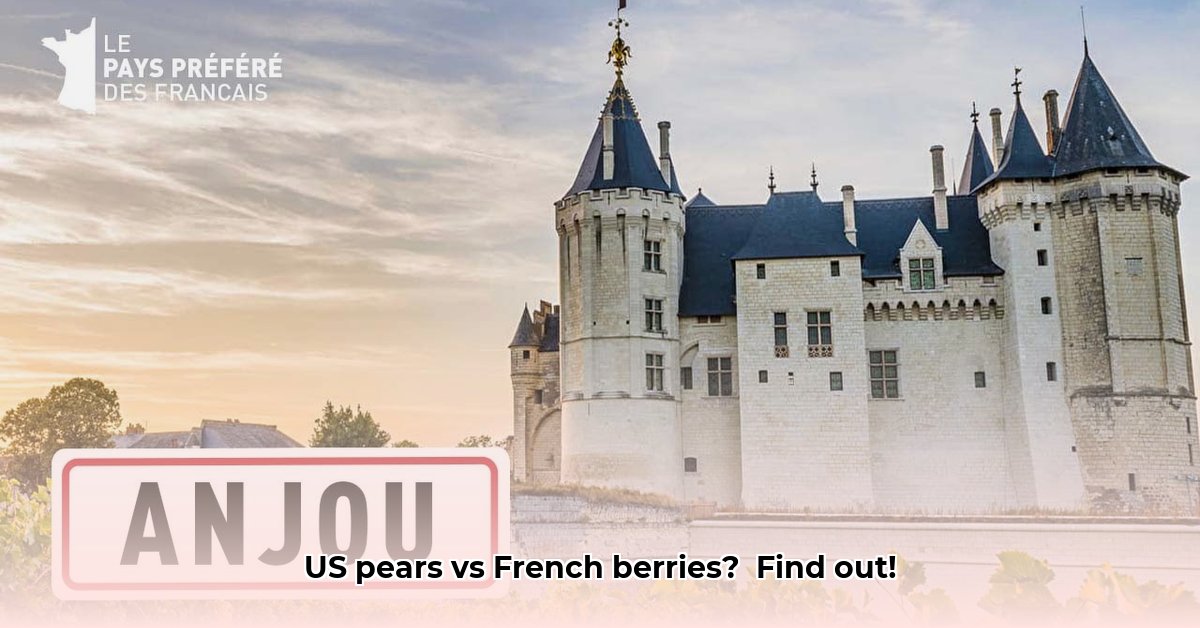
Anjou Fruit: A Tale of Two Treats – Pears from the States and Berries from France
Ever sunk your teeth into a perfectly ripe Anjou pear, its juice sweet and satisfying? Or maybe savoured a handful of sun-ripened Anjou Fruits Rouges, bursting with flavour? This isn't just a tale of two tasty treats; it's a story of contrasting farming landscapes, market forces, and the challenges faced by agricultural producers on both sides of the Atlantic. We'll explore the Anjou pear's journey from Oregon's orchards to your kitchen table, and contrast it with the exquisite Anjou Fruits Rouges from France's Loire Valley, highlighting the unique challenges and rewards of each.
The Anjou Pear: An American Orchard Star
Imagine vast orchards stretching across Oregon's sun-drenched hills, the birthplace of a substantial portion of America's Anjou pear crop. These aren't your ordinary pears; the Anjou possesses a unique trait – it ripens from the inside out. You might pick a firm, almost hard pear, knowing it will magically soften and sweeten over the next few days. This fascinating ripening process dictates careful handling throughout harvesting and transport – a complexity often unseen by the consumer. "The Anjou's inside-out ripening presents unique post-harvest challenges," notes Dr. Evelyn Reed, Professor of Horticulture at Oregon State University. "Maintaining quality throughout the supply chain requires precise temperature and humidity control."
Its versatility contributes to the Anjou's popularity: equally at home in a salad, baked into a pie, or enjoyed as a snack. However, the Anjou's success isn't without hurdles. Climate change, with its unpredictable weather patterns, poses a considerable threat. Farmers are proactively adapting, embracing sustainable practices to mitigate the impact of changing seasons and potential water shortages. Research into hardier pear varieties, resistant to pests and disease, is underway, promising a more resilient future.
Anjou Fruits Rouges: A Taste of French Excellence
Now, let's jet across the Atlantic to France's picturesque Loire Valley. Here, amidst rolling vineyards and charming villages, lies the source of Anjou Fruits Rouges – a delightful medley of blueberries, raspberries, blackberries, and strawberries, each boasting exceptional flavour and quality. These aren't your average supermarket berries. The emphasis here is intensely on taste, reflecting the painstaking care taken by farmers. Each berry receives the perfect balance of sunlight, water, and care, a dedication that translates into exceptional flavour and sweetness.
This commitment to quality, however, translates into a higher price tag. The meticulous farming practices increase production costs, though many believe it's an investment worth making. "The Anjou Fruits Rouges represent a dedication to artisanal production," explains Jean-Pierre Dubois, a Loire Valley berry farmer. "The focus on quality translates to a premium product that consumers appreciate."
Comparing the Contenders: Pears and Berries – A Side-by-Side Look
Let's summarise the key differences between these Anjou "cousins."
| Feature | Anjou Pear (US) | Anjou Fruits Rouges (France) |
|---|---|---|
| Fruit Type | Single, large pear | Mix of smaller berries (blueberries, raspberries, etc.) |
| Farming Style | Large-scale commercial production | Smaller-scale, artisan focus on quality and flavour |
| Ripening | Inside-out, requiring careful handling | Traditional ripening process |
| Market Position | Widely available, versatile culinary applications | Premium market, focused on exceptional taste experiences |
| Major Challenges | Climate change impacts, maintaining post-harvest quality | Maintaining high quality standards, managing production costs |
How to Compare Profitability of Anjou Pear and French Berry Farming
Key Takeaways:
- Profitability in Anjou pear farming hinges on size and grade management, necessitating strategic sales mix adjustments and supply chain optimization.
- Understanding market demand is crucial for predicting the economic impact of various marketing strategies.
- Sustainable farming practices, while environmentally beneficial, also influence pear quality and overall profitability.
- Comparing Anjou pear and French berry profitability demands a holistic approach, considering production costs, market dynamics, and long-term impacts of farming methods.
How do we truly compare the economic potential of Anjou pears and French berries? It’s not a simple equation, but rather a complex interplay of yield, costs, market demand, and sustainability. Let's delve deeper.
Pear Profitability: Size and Grade
Anjou pear profitability is intrinsically linked to size and grade. Larger, higher-grade pears fetch higher prices. Efficient harvesting, packaging, and transport are vital to minimise losses, while retailers must price strategically to reflect the value of different grades. However, a lack of readily available data on the precise relationship between size, grade, and price highlights a need for further research.
French Berry Profitability: A Multifaceted Market
French berry farming presents a different challenge. While yield matters, market value is also tied to factors like specific berry type, flavour profile, and consumer demand. This makes direct comparison with Anjou pears difficult without granular data on individual berry types, each having unique production costs, shelf-life issues, and market dynamics.
A Holistic Comparison: Beyond Simple Metrics
To compare effectively, we need to consider: yield (per hectare), production costs (labour, transport, etc.), market prices, and the environmental impact of different farming practices. A comprehensive analysis requires collecting market data for both Anjou pears and various French berry types, enabling a more nuanced understanding of their relative profitability.
The Future of Fruit Farming: A Collaborative Effort
Understanding the profitability of both Anjou pears and French berries necessitates collaboration between farmers, packers, distributors, and researchers. By sharing data and insights, and embracing sustainable practices, we can optimize production, reduce waste, and improve profitability without compromising environmental responsibility or consumer preferences. This collaborative approach is key to unlocking the full potential of these delightful fruits.